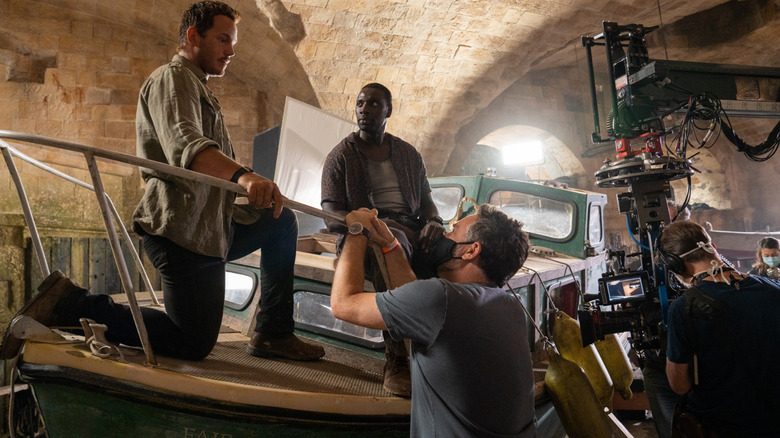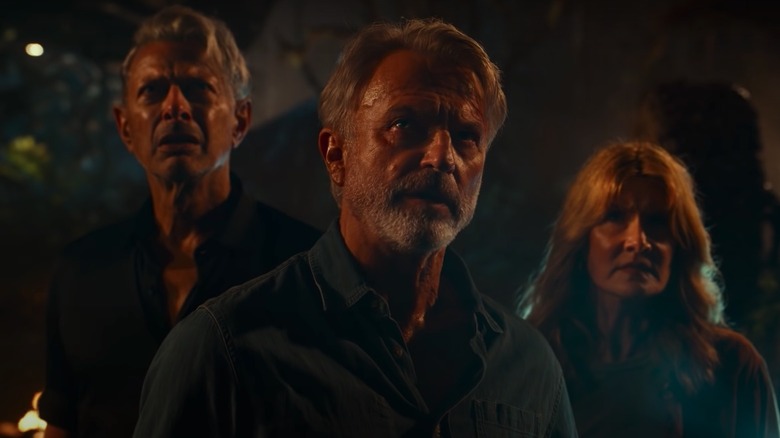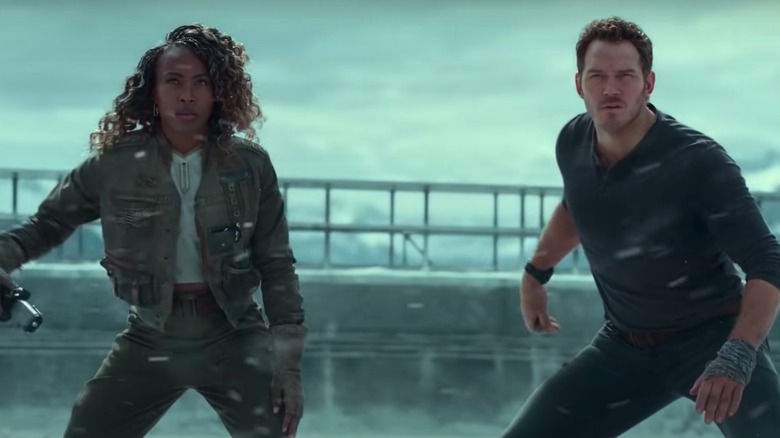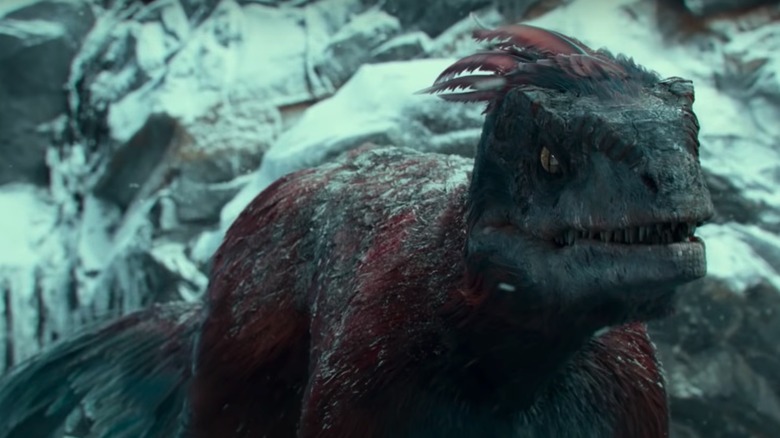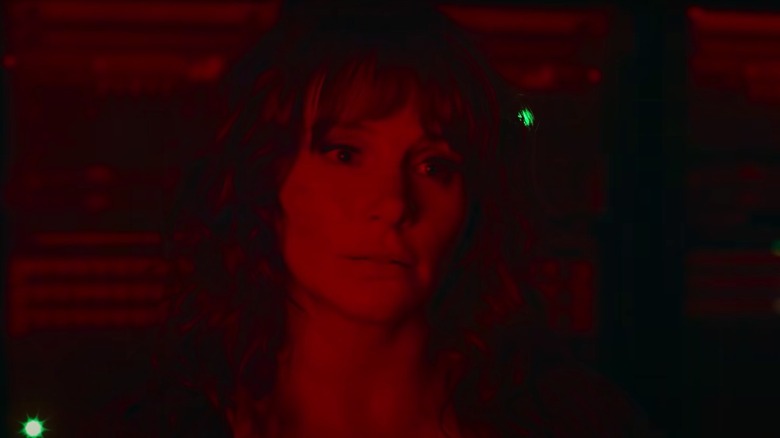Jurassic World Dominion Director Colin Trevorrow On Feathered Dinos And Combining Casts [Interview]
"Jurassic World Dominion" marks the conclusion of the second "Jurassic" trilogy, and I got a chance to chat with director Colin Trevorrow about what's coming. In the film, the dinosaurs are off Isla Nublar and are integrating with human society. Some of them are friendly(ish). Some of them are running in herds. And some of them really, really want to eat you, because you look really tasty. There are new threats from the humans as well, plus new dinosaurs to be seen and a corporation that has ulterior motives.
I spoke to Trevorrow about bringing back original cast members Laura Dern, Sam Neill, and Jeff Goldblum, using as many practical effects as possible, how Steven Spielberg let Trevorrow use the original Panavision camera used on the first film, and so much more. Strap into your gyrospheres, practice your dino-pronunciations, and give a tiny wave to the T. rex as we go deep into "Jurassic World Dominion."
This interview has been edited for clarity and brevity.
The return of the original crew
When you first read the [Michael Crichton] book, could you have imagined being where you are now?
Oh. No one's asked me about the book before. I was in Mexico on an island called Isla de Mujeres, which was off the coast of Cancun, with my family. I was probably 12, 13 years old. No. Of course not. That's the answer. I could never have imagined that I would have the responsibility to make not one, but three sequels to one of the most thrilling movies ever made by our greatest filmmaker now.
Having the actors from the first trilogy in here was such a cool thing to see. How did that come about?
You know, it came out of a real desire to show them the respect they deserve. I first saw "Jurassic Park" when I was 16 years old, and these three actors are not just icons themselves, but the characters have become iconic. And to have a whole generation then that has lived a very long time with these scientists at the forefront of this franchise in their memory, honestly, it would feel wrong to not know how they react to this new equilibrium that's been created on the planet. And it felt like it was an opportunity for two generations of moviegoers to come together and enjoy something in the same way, even if it's for different reasons, you know?
I'd love to hear about how you balanced the CGI and practical effects here.
We use practical effects and sets and environments whenever possible. So if you're going to see something that was, I'll say enhanced in a computer or animated, it's only because we couldn't do it any other way. And to me that's part of the legacy of the franchise. It's also just my own interest as a filmmaker and my desire to get in there with robots that look like dinosaurs. The coolest thing ever. And I love that over this time we finally have had the resources to be able to have a full-size Giganotosaurus out chomping people.
You used the original Panavision camera.
The original Panavision from "Jurassic Park," yeah, yeah. I was in Steven's office, and I looked at it. I was writing. For some reason, he let me stay in there and write. I kept looking up from my laptop and seeing this camera. It said, "Jurassic Park." He came back in. I was like, "Can we use that just for a second?" He was like, "Yeah, sure. Pack that up for Colin." It was two years before we actually did it, but he actually remembered and, yeah, he delivered on the promise.
Now, I also heard there was a [camera] rig called Dorothy.
Dorothy is the rig we used for Bryce's chair ... that was Bryce's first day back after we restarted for the pandemic. What we wanted to do is, we were sending her out in an ejection seat, and we wanted it to feel as if we had mounted the camera to the ejection seat, and it was really happening. We didn't have some digital camera flying around, capturing everything.
So we mounted cameras to a real ejection seat and put it on a rig that was going to move her all around while wind was blowing in her face. It feels real because her performance feels so real. Also, everything you're seeing around it was captured out in Switzerland. These are all real environments that we built. Bryce can do anything, but "make you feel like she is in absolute mortal danger" is one of the things she can do extremely well.
Shooting during Covid
As far as Covid, since you mentioned that, you guys were the first production back. What was that whole experience like?
At first, there were three months that we had to shut down. We had been shooting for about three weeks before that. We had incredible producers, Alex Derbyshire and Pat Crowley, who sat down with a team of doctors and nurses, and people who were just focused on security in general, and we kind of created a book, in a way, that was a plan that other productions ended up following, because we managed to succeed.
But somebody had to go first. I think there was just this moment where, because we didn't know what was going to happen, there was this sense that we should jump, because there's so many people whose lives rely on — so many crew members who we need to support livelihoods and families. I'll always really appreciate the actors for being willing to come back and make the movie in a time that felt dangerous and unsure, because it allowed all of our crew to go back to work.
I was talking to DeWanda [Wise], and she was saying that it was actually kind of great, but it was a shock to walk into the hotel and have people say, "Well, you live here now."
We did live there, didn't we? For four months, I didn't see my family except for one day where we got to take a little walk, masked, in the garden. I lived 20 minutes away, because I live in England. It's very hard. It reminded me of that time — I remember that movie with Fievel ["An American Tail"], where they're both looking at the same star. I would sing that song in my head as I was looking out the window. I was like, "They're out there."
In DeWanda's character's plane, you've got [a photo of DeWanda's actual] family in there. I know added a lot of little touches. Were there specific little story things you wanted to put in there, maybe for a spinoff film?
Well, I love that we put a picture of her parents. That was special. We just created a space, and I asked her to fill that space. She put her mom and dad in there, which I thought was really great. And what kind of music she listens to and all of it. I think that for an actor to be able to create a personal space that's iconic in its own way, the way that the Midnight Oiler is — there's a Lego of it now. I just remember sending her a picture of tiny Kayla Watts and her plane. We're both so proud of it.
There have been such advances, just even since the last film, in research about dinosaurs. Were there things you had to change, stuff that you wanted to make sure you included?
Well, what we did know is that we wanted feathered dinosaurs in the third movie. That was something that, obviously, fans who know paleontology have been asking [about] for a long time — and rightly asking for it. But I wanted to make sure that it was justified narratively in the context of the lore.
It was already established that there was frog DNA in the genome, and in this film, because we were going to BioSyn, that had new advancements, that it made sense that they would've created them. But for me, it was the most exciting, because I hadn't really been able to design a new kind of dinosaur from scratch, and really figure out how is this going to — we know this is going to be embedded in the memories of children for a very long time, and it's going to be toys, and they're going to believe this is what the animal looked like. So we consulted with our paleontologist, and really tried to find a balance between real and awesome-movie-scary. You've got to find that place right in between.
Biosyn is interesting because it has a connection to the original film, and I'd love to hear your thoughts on that type of corporation and what they could do to the world.
Well, Biosyn in this film is really a place with most of its employees having the best intentions. I don't think there's an evil corporation. Corporations are made up of thousands of people who all work for a company and most cases, if not all, believe in the company they work for. But oftentimes they can be betrayed by the people up on top. So this is about, really, one guy who's making a lot of decisions that a lot of the people who work for him, brilliant young people who have come with great faith that Biosyn is doing the right thing, are going to feel betrayed by.
Dinosaurs in the snow
The other thing is really interesting, that you have dinosaurs in snow. That's not something that people really think about. I kind of love that.
Well, for me, it was about just showing how displaced they are, and how probably a raptor like Blue would be shocked and then realize, "Oh, I have to adapt. I have to adjust for this," because she doesn't want to go too far away from Owen, who she has a connection with. That, to me, once we took them off the island, I didn't want any of them to be comfortable, because I want the audience to really want them to find a home, to find safety. Because hopefully, that's where we can all land.
Obviously, everyone's favorite dinosaur is T-rex at some point in their life. They're so cool. But one of the things that I've found with these movies is that T-rex becomes the hero in a way. Can you talk a little bit about the decision to do that?
I think, for me, it was because I know that the T-rex is the hero to us because of "Jurassic Park." I don't consider dinosaurs actual villains or actual heroes. They're predators and prey. We always try to create a dynamic, unless it's some freak of science, like the hybrids that were created. This movie doesn't have any hybrids. It's real dinosaurs that are in the paleontological record. Every time we create a sequence — even, we have an herbivore, the Therizinosaurus is an herbivore — we really try to communicate to the audience exactly why these two animals are fighting in the first place.
I love the baby dinosaurs — they're just so cute. I'm assuming, obviously, there's going to be a million toys, but when you're creating something like that, how much research is there out there about what the babies look like? Because I know they just found that dinosaur egg with the embryo in it.
Right. Our paleontologist works really closely with everyone at ILM. We always start with a skeletal structure. They kind of rewind it back, in a way, to what a baby would've looked like. When we made Beta, who was genetically identical to Blue, we didn't want to just make a carbon copy of Blue that was smaller. So we thought about how all of us, when you look at a four-year-old version of you and you, how does someone actually change over time? So we did a lot of rewinding.
I want to ask you what you think the coolest dinosaur is in this film.
I'm a Therizinosaurus man. I know there's a lot of dinosaurs to choose from. I think that it redefines a little bit what we know that a dinosaur could even look like or be, so that's my favorite.
You had your actors going through some pretty intense physical stunts. Was there one that was particularly difficult?
There was a moment when Chris Pratt jumped into a hard ice surface that then cracked, and he fell into ice water. DeWanda was running alongside him, and she runs just fine. So we had this tank underneath the space that Chris was going to run. We couldn't do it a bunch of times. So just both of them landing it exactly the same moment, and him dropping in, and she continues to run, getting the timing on that was tough.
The legacy of the two trilogies
That sequence on the ice was one of those things that, even in the trailer, everyone was like, "What's going on here?" What were the other challenges with that particular scene?
Well, that was the first day back when we started shooting after the pandemic. So that moment when both Owen (Pratt) and Kayla (Wise) draw their weapons together, that was day one as we returned. We had snow going. It was a massive set. There's a real plane crash. We really, really went for it, because we just built so much on the movie. We didn't have that moment where we could all just do something simple and easy. We just dove right in.
There's a big scene where everybody from both trilogies comes together. It was one of those tear-up moments. What was it like for you?
I knew it was going to be emotional inherently, so I didn't want to play to that, because just seeing them together is going to give you a lot of memories. So what I wanted to do is just press the "danger" button right away, and put them into a situation where they all had to survive together, because I think that's really what we actually are coming here to see.
I'm really curious about whether or not you are going to say this is the end point, because there was a little tiny bit left open for a possible new movie.
Well, I'll say this: For me, this is the end of this six-movie story we've been telling for 30 years. There's also new characters in this movie who I love and were created, hopefully, with the intention if the audience wants to see more of their adventures, they can have them. Kayla Watts and Ramsay Cole and Dichen Lachman's character, Soyona Santos, I think they're all amazing, and especially in a movie that has these legacy characters and our "Jurassic World" characters, there's so much oxygen that can be taken up, [so] for them to punch through and make their own stamp on it the way that they do I think is extraordinary.
What do you want people to take away, just the legacy of "Jurassic Park" and "Jurassic World?"
I think everyone's going to have their own personal connection with it based on at what point in history they were introduced, how old they were. I love the personal connection that we have with these myths that were created by mostly Steven and George during this very short period of time.
I hope with this one that people feel like I've treated it with respect, that I've made bold new decisions that have made this richer and deeper. And ultimately recognize that dinosaurs are a reminder of how very briefly we've been on this planet, and that we shouldn't treat this place as if we own it, because we coexist with a lot of living things.
"Jurassic World Dominion" arrives in theaters on June 10, 2022.
